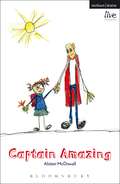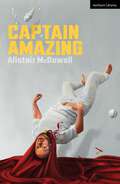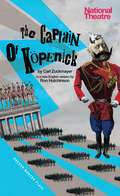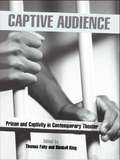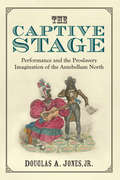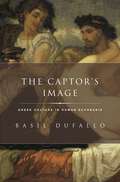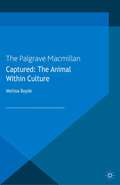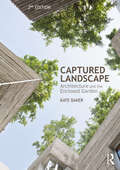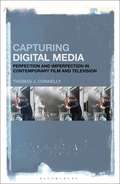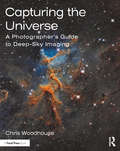- Table View
- List View
Captain Amazing: Brilliant Adventures; Captain Amazing; Talk Show; Pomona (Modern Plays)
by Alistair McDowallMy dad is a superhero. No one else knows 'cos it has to stay a secret.Alistair McDowall's play is a funny and poignant one-man show that thrusts us into the life of Britain's only part-time superhero. Struggling to balance his family responsibilities and more conventional job with defeating super-villains and rescuing families from burning buildings, Captain Amazing represents how all parents strive to be heroes in the eyes of their children. Discover this man's origins, his family life, and how even the invincible aren't immune to tragedy.Captain Amazing received its world premiere at the Edinburgh Festival Fringe 2013, starring Mark Weinman, and directed by Clive Judd. It was revived for a national tour from March 2014.'[He] is the kind of man you wouldn't look twice at in the street: balding; stooped; tentative. He's skating over the surface of life, marking time with his job at B&Q, barely acquiring possessions, not speaking to his alcoholic father. And then he meets a woman who does look twice at him; who gives birth to their daughter, Emily, and suddenly Emily is convinced that her beloved father is a superhero.' Daily Telegraph
Captain Amazing: Brilliant Adventures; Captain Amazing; Talk Show; Pomona (Modern Plays)
by Mr Alistair McDowallWhat do you do as Captain Amazing?Fight… baddies and things. Save people… make people go to bed when they're supposed to go to bed… Join the world's most unassuming superhero in Alistair McDowall's (Pomona, The Glow, X, all of it) critically-acclaimed masterpiece. From battling his arch-nemesis, to getting his daughter to school on time, follow Captain Amazing on his incredible adventures and discover how even the invincible aren't immune to tragedy.A hilarious and heart-breaking adventure which reminds us that one day, even the bravest of superheroes will need to hang up their cape… forever.This edition was published to coincide with the 10th anniversary production at London's Southwark Playhouse in May 2024.
Captain Amazing (Modern Plays)
by Mr Alistair McDowallWhat do you do as Captain Amazing?Fight… baddies and things. Save people… make people go to bed when they're supposed to go to bed… Join the world's most unassuming superhero in Alistair McDowall's (Pomona, The Glow, X, all of it) critically-acclaimed masterpiece. From battling his arch-nemesis, to getting his daughter to school on time, follow Captain Amazing on his incredible adventures and discover how even the invincible aren't immune to tragedy.A hilarious and heart-breaking adventure which reminds us that one day, even the bravest of superheroes will need to hang up their cape… forever.This edition was published to coincide with the 10th anniversary production at London's Southwark Playhouse in May 2024.
The Captain of Köpenick (Oberon Modern Plays)
by Ron Hutchinson Carl Zuckmayer‘I used to think all the trouble in the world was caused by people giving orders. Now I reckon that it’s people being so willing to take them.’ Released after fifteen years in prison, trapped in a bureaucratic maze, petty criminal Wilhelm Voight wanders 1910 Berlin in desperate, hazardous pursuit of identity papers. Luck changes when he picks up an abandoned military uniform in a fancy-dress shop and finds the city ready to obey his every command. At the head of six soldiers, he marches to the Mayor’s office, cites corruption and confiscates the treasury with ease. But still what he craves is official recognition that he exists.A nation heads blindly towards war as the misfit takes on thestate in Ron Hutchinson’s savagely funny new version of Carl Zuckmayer’s The Captain of Köpenick, first staged in Germany in 1931.
Captive Audience: Prison and Captivity in Contemporary Theatre (Studies in Modern Drama)
by Thomas Fahy Kimball KingThe first collection on this important topic, Captive Audience examines the social, gendered, ethnic, and cultural problems of incarceration as explored in contemporary theatre. Beginning with an essay by Harold Pinter, the original contributions discuss work including Harold Pinter's screenplays for The Handmaid's Tale and The Trial, Theatrical Prison Projects and Marat/Sade. Kimball King, Thomas Fahy, Rena Fraden, Tiffany Ana Lopez, Fiona Mills, Harold Pinter, Ann C. Hall, Christopher C. Hudgins, Pamela Cooper, Robert F. Gross, Claudia Barnett, Lois Gordon
Captive Audience: Prison and Captivity in Contemporary Theatre (Studies in Modern Drama #19)
by Thomas Fahy Kimball KingThe first collection on this important topic, Captive Audience examines the social, gendered, ethnic, and cultural problems of incarceration as explored in contemporary theatre. Beginning with an essay by Harold Pinter, the original contributions discuss work including Harold Pinter's screenplays for The Handmaid's Tale and The Trial, Theatrical Prison Projects and Marat/Sade. Kimball King, Thomas Fahy, Rena Fraden, Tiffany Ana Lopez, Fiona Mills, Harold Pinter, Ann C. Hall, Christopher C. Hudgins, Pamela Cooper, Robert F. Gross, Claudia Barnett, Lois Gordon
Captive Fathers, Captive Children: Legacies of the War in the Far East (New Directions in Social and Cultural History)
by Terry SmythWhy are the daughters and sons of Far East prisoners of war still captivated by the stories of their fathers? What is it that compels so many of the children, after so many years, to search for the details of their fathers' captivity? And how, over the decades, have they come to terms with their childhood memories? In his book Terry Smyth treads new ground by examining the processes through which the children's memory practices came to be rooted in the POW experiences of their fathers. By following a life course approach, and a psychosocial methodology, the book demonstrates how memory and trauma were 'worked into' the social and cultural lives of individual children, and explores how the relationship between their inner psychic worlds and subsequent memory practices unfolded against a challenging and morally ambivalent geopolitical background. The book invites readers to engage with the author in a journey of exploration and self-reflection, with elements of auto-ethnography adding richness to the text. Enlivened by interview extracts, case study material and ethnographic observations, this work opens up fresh and ambitious perspectives on the personal legacies of war.
Captive Fathers, Captive Children: Legacies of the War in the Far East (New Directions in Social and Cultural History)
by Terry SmythWhy are the daughters and sons of Far East prisoners of war still captivated by the stories of their fathers? What is it that compels so many of the children, after so many years, to search for the details of their fathers' captivity? And how, over the decades, have they come to terms with their childhood memories? In his book Terry Smyth treads new ground by examining the processes through which the children's memory practices came to be rooted in the POW experiences of their fathers. By following a life course approach, and a psychosocial methodology, the book demonstrates how memory and trauma were 'worked into' the social and cultural lives of individual children, and explores how the relationship between their inner psychic worlds and subsequent memory practices unfolded against a challenging and morally ambivalent geopolitical background. The book invites readers to engage with the author in a journey of exploration and self-reflection, with elements of auto-ethnography adding richness to the text. Enlivened by interview extracts, case study material and ethnographic observations, this work opens up fresh and ambitious perspectives on the personal legacies of war.
The Captive Stage: Performance and the Proslavery Imagination of the Antebellum North (Theater: Theory/Text/Performance)
by Douglas A JonesIn The Captive Stage, Douglas A. Jones, Jr. argues that proslavery ideology remained the dominant mode of racial thought in the antebellum north, even though chattel slavery had virtually disappeared from the region by the turn of the nineteenth century—and that northerners cultivated their proslavery imagination most forcefully in their performance practices. Jones explores how multiple constituencies, ranging from early national artisans and Jacksonian wage laborers to patrician elites and bourgeois social reformers, used the stage to appropriate and refashion defenses of black bondage as means to affirm their varying and often conflicting economic, political, and social objectives. Joining performance studies with literary criticism and cultural theory, he uncovers the proslavery conceptions animating a wide array of performance texts and practices, such as the “Bobalition” series of broadsides, blackface minstrelsy, stagings of the American Revolution, reform melodrama, and abolitionist discourse. Taken together, he suggests, these works did not amount to a call for the re-enslavement of African Americans but, rather, justifications for everyday and state-sanctioned racial inequities in their post-slavery society. Throughout, The Captive Stage elucidates how the proslavery imagination of the free north emerged in direct opposition to the inclusionary claims black publics enacted in their own performance cultures. In doing so, the book offers fresh contexts and readings of several forms of black cultural production, including early black nationalist parades, slave dance, the historiography of the revolutionary era, the oratory of radical abolitionists and the black convention movement, and the autobiographical and dramatic work of ex-slave William Wells Brown.
The Captor's Image: Greek Culture in Roman Ecphrasis (Classical Culture and Society)
by Basil DufalloAn influential view of ecphrasis--the literary description of art objects--chiefly treats it as a way for authors to write about their own texts without appearing to do so, and even insist upon the aesthetic dominance of the literary text over the visual image. However, when considering its use in ancient Roman literature, this interpretation proves insufficient. The Captor's Image argues for the need to see Roman ecphrasis, with its prevalent focus on Hellenic images, as a site of subtle, ongoing competition between Greek and Roman cultures. Through close readings of ecphrases in a wide range of Latin authors--from Plautus, Catullus, and Horace to Vergil, Ovid, and Martial, among others--Dufallo contends that Roman ecphrasis reveals an ambivalent receptivity to Greek culture, an attitude with implications for the shifting notions of Roman identity in the Republican and Imperial periods. Individual chapters explore how the simple assumption of a self-asserting ecphrastic text is called into question by comic performance, intentionally inconsistent narrative, satire, Greek religious iconography, the contradictory associations of epic imagery, and the author's subjection to a patron. Visual material such as wall painting, statuary, and drinkware vividly contextualizes the discussion. As the first book-length treatment of artistic ecphrasis at Rome, The Captor's Image resituates a major literary trope within its hybrid cultural context while advancing the idea of ecphrasis as a cultural practice through which the Romans sought to redefine their identity with, and against, Greekness.
Capture Japan: Visual Culture and the Global Imagination from 1952 to the Present
by Marco BohrCapture Japan investigates the formation of visual tropes and how these have contributed to perceptions of Japan in the global imagination. The book proposes that images are not incidental in the formation of such perceptions, but central to notions about identity, history and memory. From a tentative western ally in 1952 to a 'soft power' superpower with a huge global influence in the 21st century, the book locates questions about Japan in the global imagination to the country's transforming geopolitical position. By adopting an interdisciplinary approach, with a multiplicity of perspectives from around the world, Capture Japan goes beyond binarisms to uncover how images can also produce discourses that challenge, subvert or even contradict each other. The word 'capture' in the title of the book recognises both the deeply problematic role that images have played in relation to colonialism, as well as the potential dominance that visual spectacles can wield in a contemporary context. Diverse essays from a wide range of perspectives investigate the institutional framework that has allowed certain types of images of Japan to be promoted, while others have been suppressed.In doing so, the book points to a vast network of images that have shaped the perception of Japan both from within and from outside, revealing how these images are inextricably linked to wider ideological, political, cultural or economic agendas.
Capture Japan: Visual Culture and the Global Imagination from 1952 to the Present
Capture Japan investigates the formation of visual tropes and how these have contributed to perceptions of Japan in the global imagination. The book proposes that images are not incidental in the formation of such perceptions, but central to notions about identity, history and memory. From a tentative western ally in 1952 to a 'soft power' superpower with a huge global influence in the 21st century, the book locates questions about Japan in the global imagination to the country's transforming geopolitical position. By adopting an interdisciplinary approach, with a multiplicity of perspectives from around the world, Capture Japan goes beyond binarisms to uncover how images can also produce discourses that challenge, subvert or even contradict each other. The word 'capture' in the title of the book recognises both the deeply problematic role that images have played in relation to colonialism, as well as the potential dominance that visual spectacles can wield in a contemporary context. Diverse essays from a wide range of perspectives investigate the institutional framework that has allowed certain types of images of Japan to be promoted, while others have been suppressed.In doing so, the book points to a vast network of images that have shaped the perception of Japan both from within and from outside, revealing how these images are inextricably linked to wider ideological, political, cultural or economic agendas.
Captured: The Animal within Culture
by Melissa BoydeIn 2008 the youtube video documenting the emotional reunion between two men and Christian the Lion became a worldwide sensation. Key themes of the essays in Captured: the Animal within Culture are encapsulated in Christian's story: the implications of the physical and cultural capture of animals.
Captured Landscape: Architecture and the Enclosed Garden
by Kate BakerThe enclosed garden, or hortus conclusus, is a place where architecture and landscape come together. It has a long and varied history, ranging from the early paradise garden and cloister, the botanic garden and giardini segreto, the kitchen garden and as a stage for social display. The enclosed garden has continued to develop into its many modern forms: the city retreat, the redemptive garden, the deconstructed building. As awareness of climate change becomes increasingly important, the enclosed garden, which can mediate so effectively between interior and exterior, provides opportunities for sustainable design and closer contact with the natural landscape. By its nature it is ambiguous. Is it an outdoor room, or captured landscape; is it architecture or garden? Kate Baker discusses the continuing relevance of the typology of the enclosed garden to contemporary architects by exploring influential historical examples and the concepts they generate, alongside some of the best of contemporary designs – brought to life with vivid photography and detailed drawings – taken primarily from Britain, the Mediterranean, Japan and North and South America. She argues that understanding the potential of the enclosed garden requires us to think of it as both a design and an experience. Captured Landscape provides a broad range of information and design possibilities for students of architectural and landscape design, practising architects, landscape designers and horticulturalists and will also appeal to a wider audience of all those who are interested in garden design. This second edition of Captured Landscape is enriched with new case studies throughout the book. The scope has now been broadened to include an entirely new chapter concerning the urban condition, with detailed discussions on issues of ecology, sustainability, economy of means, well-being and the social pressures of contemporary city life.
Captured Landscape: Architecture and the Enclosed Garden
by Kate BakerThe enclosed garden, or hortus conclusus, is a place where architecture and landscape come together. It has a long and varied history, ranging from the early paradise garden and cloister, the botanic garden and giardini segreto, the kitchen garden and as a stage for social display. The enclosed garden has continued to develop into its many modern forms: the city retreat, the redemptive garden, the deconstructed building. As awareness of climate change becomes increasingly important, the enclosed garden, which can mediate so effectively between interior and exterior, provides opportunities for sustainable design and closer contact with the natural landscape. By its nature it is ambiguous. Is it an outdoor room, or captured landscape; is it architecture or garden? Kate Baker discusses the continuing relevance of the typology of the enclosed garden to contemporary architects by exploring influential historical examples and the concepts they generate, alongside some of the best of contemporary designs – brought to life with vivid photography and detailed drawings – taken primarily from Britain, the Mediterranean, Japan and North and South America. She argues that understanding the potential of the enclosed garden requires us to think of it as both a design and an experience. Captured Landscape provides a broad range of information and design possibilities for students of architectural and landscape design, practising architects, landscape designers and horticulturalists and will also appeal to a wider audience of all those who are interested in garden design. This second edition of Captured Landscape is enriched with new case studies throughout the book. The scope has now been broadened to include an entirely new chapter concerning the urban condition, with detailed discussions on issues of ecology, sustainability, economy of means, well-being and the social pressures of contemporary city life.
Capturing Colour (Basics Photography)
by Phil MalpasBasics Photography 03: Capturing Colour gives readers a comprehensive introduction to the subject of colour and how to master its use in the process of photographic image-making. The topics discussed range from basic colour theory to the colour temperature of light and how to use colour to maximize the impact of compositions. A full and intimate understanding of colour is vital to the creation of dramatic, emotive and powerful photographic images. The way we choose to use colour will greatly influence the success of our image-making.
Capturing Colour (Basics Photography)
by Phil MalpasBasics Photography 03: Capturing Colour gives readers a comprehensive introduction to the subject of colour and how to master its use in the process of photographic image-making. The topics discussed range from basic colour theory to the colour temperature of light and how to use colour to maximize the impact of compositions. A full and intimate understanding of colour is vital to the creation of dramatic, emotive and powerful photographic images. The way we choose to use colour will greatly influence the success of our image-making.
Capturing Digital Media: Perfection and Imperfection in Contemporary Film and Television
by Thomas J. ConnellyWhy are filmmakers such as J.J. Abrams, Christopher Nolan and Quentin Tarantino continuing to shoot their movies on celluloid in the digital age of cinema? Are these filmmakers choosing the photochemical process of celluloid images purely for aesthetics purposes? Or could their preference for celluloid have something to do with analogue's intimate connection to the subject of lack and desire? Capturing Digital Media: Perfection and Imperfection in Contemporary Film and Television examines the relationship between the perfection of the digital form and the imperfection of the human subject in recent film and television. Using a number of a key psychoanalytic terms and new media concepts, Capturing Digital Media shows that the necessity of imperfection is where we locate the human subject of desire within the binary logic of the digital. It argues that the perfection of digital must be wounded by forms of imperfection in order to make media texts such as film and television desirable. But even as films and television texts incorporate forms of imperfection, digital perfection remains a powerful attraction in our engagement with moving images, such as high definition screens, spectacular digital effects, and state-of-the-art sound.
Capturing Digital Media: Perfection and Imperfection in Contemporary Film and Television
by Thomas J. ConnellyWhy are filmmakers such as J.J. Abrams, Christopher Nolan and Quentin Tarantino continuing to shoot their movies on celluloid in the digital age of cinema? Are these filmmakers choosing the photochemical process of celluloid images purely for aesthetics purposes? Or could their preference for celluloid have something to do with analogue's intimate connection to the subject of lack and desire? Capturing Digital Media: Perfection and Imperfection in Contemporary Film and Television examines the relationship between the perfection of the digital form and the imperfection of the human subject in recent film and television. Using a number of a key psychoanalytic terms and new media concepts, Capturing Digital Media shows that the necessity of imperfection is where we locate the human subject of desire within the binary logic of the digital. It argues that the perfection of digital must be wounded by forms of imperfection in order to make media texts such as film and television desirable. But even as films and television texts incorporate forms of imperfection, digital perfection remains a powerful attraction in our engagement with moving images, such as high definition screens, spectacular digital effects, and state-of-the-art sound.
Capturing Light: The Heart of Photography
by Michael FreemanFor professional photographers, chasing the light, waiting for it, sometimes helping it, and finally capturing it is a constant preoccupation and for some, an obsession. Drawing on four decades of working with light, Michael Freeman takes a simple but practical approach to interpreting, reacting to, and capturing photography's most valuable commodity.Practical advice is organised into three straightforward sections: Waiting, Chasing, and Helping. Begin by mastering the art of patience, and recognise the immense value of anticipating and planning for gorgeous light that's just over the horizon. Then learn the techniques to meet otherwise transient and fleeting lighting conditions halfway, with quick thinking and fast reactions. Finally, make the most of the tools at your disposal to enhance and manipulate light as you find it, covering everything from in-the-field shooting choices to technical transformations in post-production. This is the method of a working professional the way to interpret, approach, and master whatever lighting situation is thrown at you and always get the shot, no matter what.
Capturing The Moment: The Essence of Photography
by Michael FreemanThis is not a book about the fundamentals of shutter speed or how your camera works; it is a book that will teach photographers of all levels how to work with their cameras to capture moments whether they are occurring quickly or unfolding over many hours. Capturing the Moment is about a gesture, an expression, a ball in the net, a whale breaching, like Marilyn Monroe’s skirt flying up or Alfred Eisenstaedt’s image of a kiss between a soldier and nurse in Times Square. Moments in all forms are the true core of photography, and this book will explain how to anticipate them, recognise them, choose them, and capture them, through the eyes and wisdom of award-winning photographer and celebrated author Michael Freeman.
Capturing The Moment: The Essence of Photography
by Michael FreemanThis is not a book about the fundamentals of shutter speed or how your camera works; it is a book that will teach photographers of all levels how to work with their cameras to capture moments whether they are occurring quickly or unfolding over many hours. Capturing the Moment is about a gesture, an expression, a ball in the net, a whale breaching, like Marilyn Monroe’s skirt flying up or Alfred Eisenstaedt’s image of a kiss between a soldier and nurse in Times Square. Moments in all forms are the true core of photography, and this book will explain how to anticipate them, recognise them, choose them, and capture them, through the eyes and wisdom of award-winning photographer and celebrated author Michael Freeman.
Capturing the Light: A Story of Genius, Rivalry and the Birth of Photography
by Roger Watson Helen RappaportCapturing the Light starts with a tiny scrap of purple-tinged paper, 176 years old and about the size of a postage stamp. On it you can just make out a tiny, ghostly image of a gothic window, an image so small and perfect that it ‘might be supposed to be the work of some Lilliputian artist’: the world’s first photographic negative. This captivating book traces the lives of two very different men in the 1830s, both racing to be the first to solve one of the world’s oldest problems: how to capture an image and keep it for ever. On the one hand there is Henry Fox Talbot: a quiet, solitary gentleman-amateur tinkering away on his farm in the English countryside. On the other Louis Daguerre, a flamboyant, charismatic French showman in search of fame and fortune. Only one question remains: who will get there first?
Capturing the South: Imagining America's Most Documented Region (Documentary Arts and Culture, Published in association with the Center for Documentary Studies at Duke University)
by Scott L. MatthewsIn his expansive history of documentary work in the South during the twentieth century, Scott L. Matthews examines the motivations and methodologies of several pivotal documentarians, including sociologist Howard Odum, photographers Jack Delano and Danny Lyon, and music ethnographer John Cohen. Their work salvaged and celebrated folk cultures threatened by modernization or strived to reveal and reform problems linked to the region's racial caste system and exploitative agricultural economy. Images of alluring primitivism and troubling pathology often blurred together, neutralizing the aims of documentary work carried out in the name of reform during the Progressive era, New Deal, and civil rights movement. Black and white southerners in turn often resisted documentarians' attempts to turn their private lives into public symbols. The accumulation of these influential and, occasionally, controversial documentary images created an enduring, complex, and sometimes self-defeating mythology about the South that persists into the twenty-first century.
Capturing the Universe: A Photographer’s Guide to Deep-Sky Imaging
by Chris WoodhouseThis book provides a thorough introduction to and exploration of deep sky astrophotography for the digital photographer. With over 280 images, graphs, and tables, this introductory book uses a progressive and practical style to teach readers how to image the night sky using existing, affordable equipment. The book opens with a brief astronomy primer, followed by chapters that build progressively to explain the challenges, offer solutions, and provide invaluable information on equipment choice through image capture, calibration, and processing in affordable software. The book’s focus ranges from how to image sweeping vistas and star trails using only a camera body, lens and tripod, to more advanced methods suitable for imaging galaxies, clusters, nebulae, and stars. Other features of the book include: Real-world assignments showing how and when to use certain tools and how to overcome challenges and setbacks Practical construction projects Evaluations of the most recent developments in affordable hardware and software Exploration on how sensor performance and light pollution relate to image quality and exposure planning Ground-breaking practical chapters on lucky imaging and choosing and using the latest CMOS cameras Written in an accessible, easy to follow format, this comprehensive guide equips readers with all the necessary skills to progress from photographer to astrophotographer.
